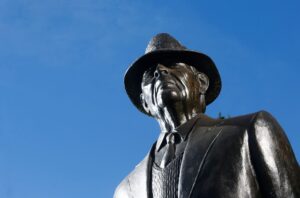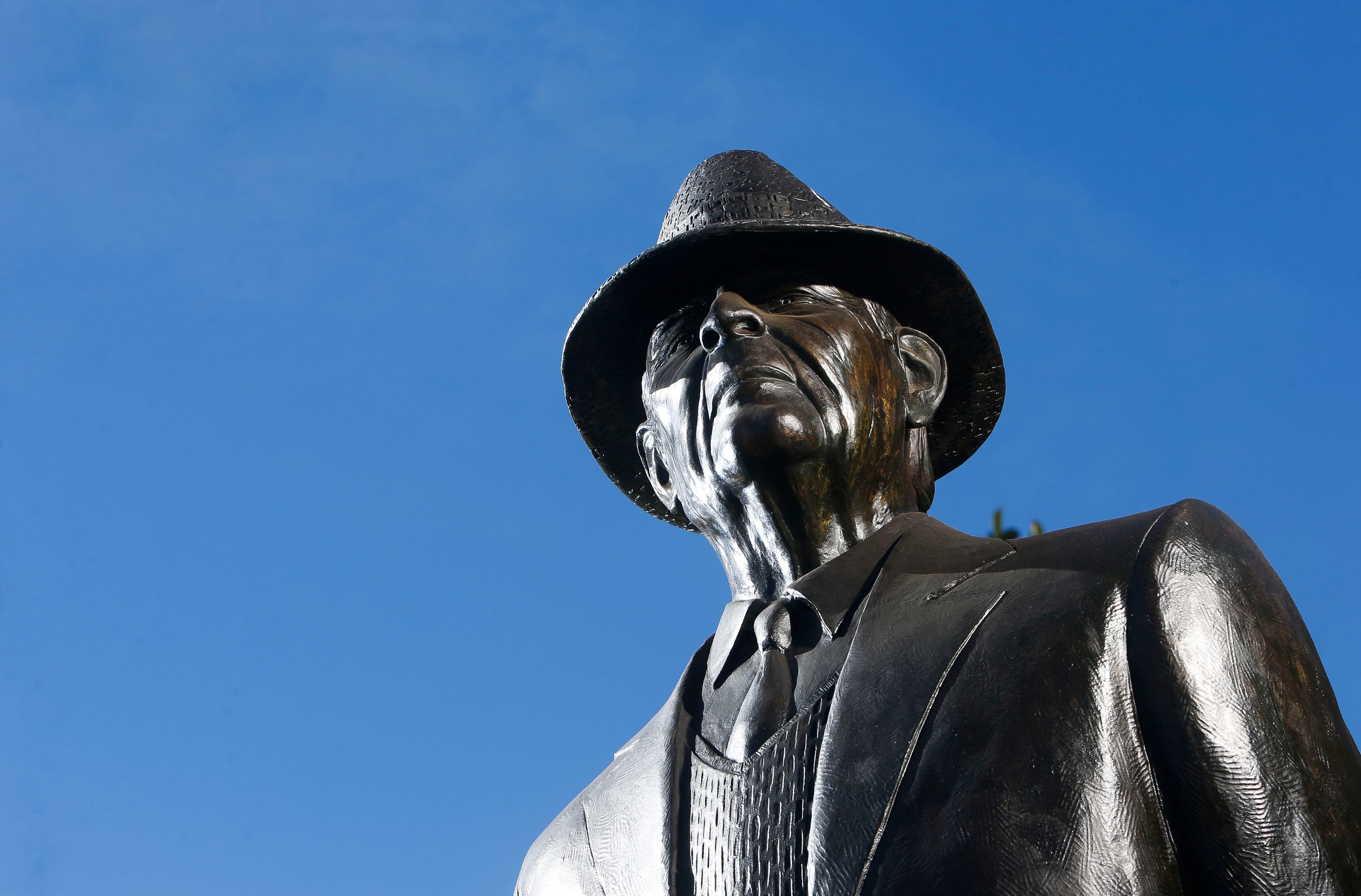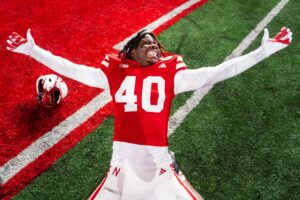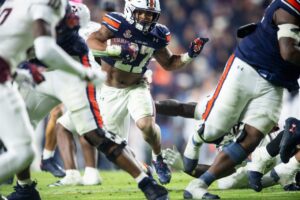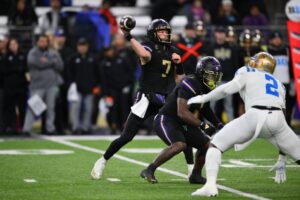It’s an uphill battle for Alabama as it prepares to move on from a coaching legend, something few teams have done successfully. Then again, no program knows about replacing a legend better than the Crimson Tide. Bear Bryant coached his final season in 1982 after winning six national championships in Tuscaloosa. It took almost a decade after his departure for Alabama to become relevant again.
Nick Saban won his seventh national title during the 2020 season and coached another three seasons. Bryant captured his sixth trophy in 1979 and gave it another three years before Ray Perkins took over. Alabama fans hope the similarities end there as they look forward to the Kalen DeBoer era. They want the Tide to stay atop the college football summit. The good news is that Alabama football is in a better position for that to happen than it was after Bryant left.
2024: The GOAT
No need to rehash Saban’s accomplishments here. They’re fused within our memory banks, and the sports world has been talking about them the past few days since the announcement dropped. DeBoer will be discussed and scrutinized ad nauseam now that he’s accepted the challenge of replacing him. It’s not every day that a legend retires, so let’s examine how other football programs went about finding their replacements and how it turned out.
Not every legend walks away from a team that’s still firing on all cylinders. Alabama had a 27-2-7 record in Bryant’s final three seasons and 8-4 in his final campaign. On the other hand, the Tide was 36-6 under Saban from 2021 until now and the cupboard is fully stocked. As history has shown, keeping the mojo intact is going to be a huge undertaking. Within the wonderful world of major college football, there exists a wasteland of broken dreams and humbled egos belonging to those who dared step into the shadows of the greatest coaches who ever lived. And then there are those rare occasions when the legend passed the torch to a worthy successor, and the machine kept rolling.
2014: Coach February
Mack Brown didn’t waste any time putting the Texas Longhorns back on the map. It was an uphill battle long in the making. He took charge of a moribund program in 1998 and led the team to a 9-3 record in his first season. It was a sign of things to come for a team that was 4-7 the year before, and a fan base still reminiscing about the good old days under Darrell Royal. Brown delivered the goods, winning at least nine games every year in his first 12 seasons including a national title in 2005. He earned the nickname “Coach February” by being one of the nation’s best recruiters during that time. It abruptly came to an end. After the 2009 season and a loss to Alabama in the National Championship Game, Texas staggered its way through a 30-21 stretch from 2010 to 2013 and he resigned.
Texas finished 9-4 and 8-5 in Brown’s final two seasons in 2012 and 2013, and fans wondered if it could get any worse. Then Charlie Strong came along and proved that it could. He was hired after leading a resurgence at Louisville during his four years there. Strong was a disciplinarian who sent players packing when they got themselves into legal trouble or violated team rules. He was also undermined, both publicly and privately, by some of the program’s biggest boosters. His stint at Texas started in 2014 with a 6-7 record and it got worse from there. The Longhorns posted consecutive records of 5-7 in 2015 and 2016 before Texas fired him.
2010: The Legend of Bobby
Bobby Bowden turned Florida State into a powerhouse in the 1990s. The Seminoles claimed national titles in 1993 and 1999. They won at least 10 games each season that decade and always ranked in the top five when the final polls were released every year. Bowden won 304 games over 34 seasons at FSU. His coaching tree includes Jimbo Fisher, Kirby Smart, Manny Diaz, Terry Bowden, and Mark Richt. It was an unrealistically high standard that could not be duplicated in the decade that followed. Bowden coached the Seminoles for the final time in 2009.
Jimbo Fisher had been waiting to take over the FSU program since being named Bowden’s successor after the 2007 season, Fisher’s first year as offensive coordinator. Unlike the situation in Alabama today, Florida State faced a more formidable uphill battle. The Seminoles were no longer at the top of the food chain when Fisher took over. Fisher rebuilt the program and won his first four bowl games, including the BCS National Championship to finish the 2013 season with a 14-0 record. The Seminoles went undefeated during the regular season in 2014 but were humiliated 59-20 by Oregon in the Rose Bowl. A pair of 10-3 seasons followed in 2015 and 2016, but FSU stumbled to 5-6 in his final season before Fisher parlayed his success into a mega contract that will live in Texas A&M infamy.
2001: The Mountain Man
LaVell Edwards was a pioneer who put BYU football on the map. He was an assistant for 10 years before taking over as head coach in 1972. In an era dominated by the rushing game, he oriented the Cougars and college football toward throwing the ball. Edwards developed outstanding quarterbacks during his 29 years as head coach. Along the way, he won a national championship in 1984 and 18 WAC titles overall. Job offers from NFL and college teams flowed Edwards’ way after the ’84 title, but he stayed in Provo and retired after the 2000 season. BYU was 6-6 in his last season.
Gary Crowton was hired as LaVell’s replacement. The former Chicago Bears offensive coordinator was born in Orem, Utah. He knew the uphill battle he was getting himself into. Just to be sure, BYU renamed its stadium after Edwards. Other than a three-year stint at Louisiana Tech, Crowton had no head coaching experience. He surprised everyone during his first season with BYU in 2001, leading the Cougars to a 12-2 record. But the program floundered from there, going 14-21 over the next three years. Crowton was forced to resign after the 2004 season. He went on to make a name for himself as one of the best offensive coordinators of his time during stints at Oregon and LSU.
1998: The King of Omaha
The story of Tom Osborne would make a great villain arc. He was a small-town boy from Nebraska with a failed NFL career who started coaching as an unpaid assistant in 1962. He became offensive coordinator seven years later and installed his system. Upon taking over as head coach in 1973, he unleashed a 25-year reign of terror that even Nick Saban couldn’t match. Osborne leads all FBS coaches with a .836 win percentage (minimum 200 wins). Osborne coached the Nebraska juggernaut until his final season in 1997.
Talk about an uphill battle. Osborne’s successor was doomed to underachieve. Nebraska was 49-2 over those last four seasons and went undefeated in 1994, 1995, and 1997. There was nowhere to go but down. Osborne turned his empire over to Frank Solich, who was an assistant with Nebraska for 19 years before being named head coach. Much to the dismay of Husker haters, Nebraska kept winning. After a 9-4 speed bump during his first season in 1998, Nebraska went 12-1, 10-2, and 11-2 the following three years. The dynasty came to an end in 2002 as the Huskers struggled through a 7-7 season and fell out of the national rankings for the first time since 1981. Nebraska fired Solich in 2003 at the end of a 9-3 season.
1997: Boo-Hoo Lou
Maybe you’ve only been following college football since breakfast and don’t recall the spectacle that was Lou Holtz. He took over a Notre Dame program that was dead in the water in 1986. Conventional wisdom at the time had determined the Fighting Irish would never be relevant again, largely because of its high admissions standards. Holtz shattered that perception over the course of 11 seasons, compiled an overall record of 100-30-2, and won a national championship. All the while, he told anyone who would listen that the sky was falling. Notre Dame was the perennial underdog, perpetually in need of a miracle to win its next game, and always behind the eight ball. He led the Irish to an 8-3 record in his last season in 1996 before moving on to coach South Carolina and start his broadcasting career.
Holtz’s replacement was already on the staff. Bob Davie was a defensive coordinator in 1994 and had been steadily improving the Irish defense since his arrival. Davie coached Notre Dame for five seasons from 1997 to 2001. It was a train wreck. He alienated fans, fired a beloved assistant coach to trigger a lawsuit for age discrimination, and misused quarterback Ron Powlus. The Irish had two losing seasons and lost all three of their bowl games during Davie’s tenure. Notre Dame fired him the day after the 2001 season ended.
